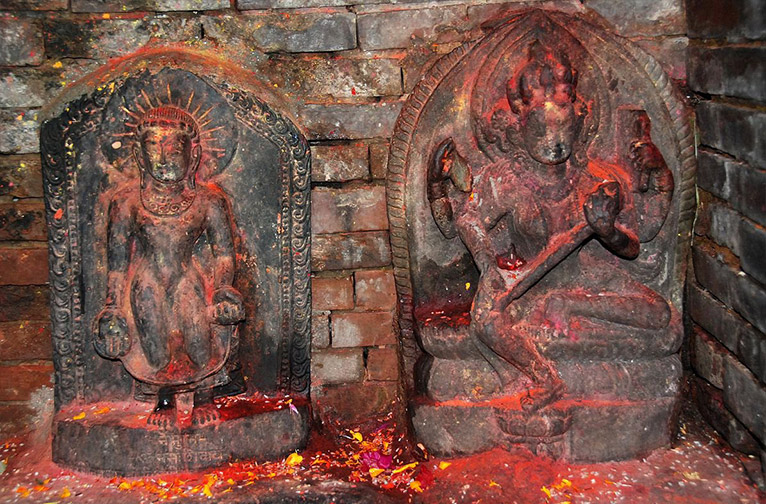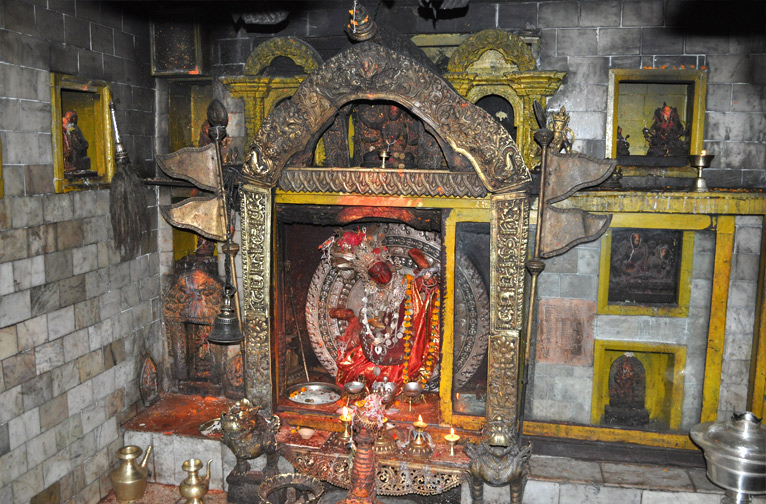An exhibit in the Global Nepali Museum (GNM) in the Cloud is a Bilampo, or horizontal scroll, featuring three dancing Buddhist deities framed within aureoles and interspersed with flowers. At the centre is a white multi-armed goddess, the largest and most powerful figure on the canvas, probably representing White Tara (the female saviour); the 18-armed goddess holds a lotus in each hand and on her forehead gleams the third eye. Flanked on her either side are two bird-headed female attendants, one blue and one green, each adorned with a necklace of human skulls— and trampling a nude male figure (ignorance). These are probably Dakinis, tantric sky dancers who play a supportive role in helping humans to overcome ignorance. A display of a banner of such a nature is common practice still to be found oftentimes, outdoors, during festivals on the walls of a temple.
The exotic mysticism of Nepal is also richly mirrored in its Tantric world. A derivative of the ancient Hindu religious traditions from India, Tantra, not so much a religion as a way of spiritual thinking and pursuit of salvation through prescribed rituals and prayers, has been deeply rooted in Nepal for ancient times. Learning how to achieve salvation through the Tantric route is possible only through a Brahmin or a Buddhist priest who is willing to initiate the seeker into its many levels of secret rites.
In fact, Tantric cultural influences in Nepal are evident not only in prayers and rituals, but also in the arts and crafts, architecture, festivals and daily routines of its practitioners. Iconic esoteric features to stimulate one mentally and spiritually, such as mandalas, chakras, yantras and mantras are richly imbued with layers of mystical symbolism.
The Kathmandu Valley was the nucleus of Tantric Buddhist practice and philosophy, as revealed by historical accounts out of Tibet and China. The valley was also a flourishing hub for art. Tantric philosophy and principles were incorporated into Hinduism and Buddhism cultures which were flourishing here in medieval times. During the reign of the Malla kings (1200–1768) it was reflected in the preponderance of erotic temple art found in the Kathmandu valley under the influence of Newari artisans. Records reveal that the Newari artist Arniko, who had been initiated into Tantric rites his guru Phagpa, was instrumental in converting the great Kublai Khan to tantric Buddhism, so blown away was he by the paintings. In 1274 Arniko, under direction of Phagpa, created an image of Mahakala, which was used in a protection ritual to help the Khan in his battles against the Southern Song, whom he vanquished in 1280.
Guhyeshwari Temple
Just a about a kilometer away from Pashupatinath temple in Kathmandu stands the venerable Tantric hub of Guhyeshwari temple, on the banks of the Bagmati River. Also a Hindu Shaktipeeth shrine, the knees of the dismembered goddess Sati, Shiva’s wife is said to have fallen here, the temple was renovated in the 17th century under orders by Pratap Malla. The goddess Shakti is worshipped as Mahamaya or Mahashira and Lord Shiva as Kapali. Scared ancient texts reveal that in this is one of the most important places for gaining the power of Tantra. Newari Vajaryana Buddhists venerate her as sacred to Vajrayogini the form of Vajravarahi and to be the location of root of the mythical lotus upon which rests the Swayambhunath stupa, which is also the umbilical cord that nurtures Kathmandu.
Temple of Vajrayogini
This tantric temple, also known as Gum Bihar, lies on a hillside near Sankhu, an old Newari town, 17 km from Kathmandu. Guru Padmasambhava, who established Tantric Buddhism or Vajrayana Buddhism in Tibet, is said to have resided here in the beginning of the 8th century in a cave close to the lake for several years. It was raised during the Licchavi period (300-879 CE). The temple complex features two pagoda-style temples on a single platform- the one to the Goddess Vajrayogini, and the other a self-emanating Swayambhu Stupa, with two sacred representations of this site — two statues of the four-armed Vajrayogini Ugra-Tara who is worshiped by both Buddhists and Hindus alike.


You enter into their divine presence through an elaborately carved gold plated gateway. The deity is deeply venerated by the high lamas and mahasiddhas of India, Tibet, Nepal, Mongolia and China. The founder of the Gelug lineage of Tibetan Buddhism, Lama Tsongkhapa, was renowned for advocating the Yamantaka, Heruka and Guhyasamaja practices, but after he entered clear light, Vajrayogini texts were found amongst his possessions and it was discovered that he had practised Vajrayogini secretly and intensely. He is a Highest Yoga Tantra yidam (meditational deity; ishtadevata in Sanskrit) and is considered to be one of the most important deities in the Tibetan pantheon simply because her practice is the easiest. Vajrayogini is considered the patron deity of Sankhu. Vajrayogini is closely associated with the founding of the Kathmandu Valley. The annual Bajrajogini Jatra features the beautifully adorned image of Vajrayogini stepping out to bless the people during an elaborate procession in Sankhu town.
Travelling around Nepal you will find an unbelievably rich repository of its Tantric connections in countless ways in temples and caves, museums and art and craft hubs— over dinner with local families or a shamanic ritual in a remote village. Keep your eyes and ears open to delve deep into this vibrant cultural legacy.